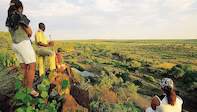
A Spot of History
Originally farmland it soon became obvious that the land was better suited to host game farms, which would in turn attract tourists, and soon the farms were all consolidated into game reserves. As a result, one of the main attractions in the Tuli Block area today, is the Northern Tuli Game Reserve.
Aside from phenomenal game viewing and bird watching, the Tuli Block also has a long and rich history as it was a strategic location for the men fighting during the South African Boer war. After the war the chief in the area; Chief Khama III relinquished the land to the British in an attempt to create a buffer against the invasions by the South African farmers.
Cecil John Rhodes also had particular interest in the land as it was on the exact line of his Cape to Cairo railway route, however he soon realised the land was unsuitable due to the large number of rivers and gorges within it.
Discover a Land Created for Giants

The Northern Tuli Game Reserve and its surrounding area have been nicknamed 'The Land of Giants' by Roger and Pat de la Harpe, in their book about the area. 'The Land of Giants' refers to the sheer enormity of the elements found in the area.
The large herds of game animals found on the safari plains, including Eland, the expansive blue skies, massive rocky masses and the towering baobab trees are just some of the giants that await visitors to the reserve.
A Contorted and Tortured Landscape
The striking geographical features of the landscape include the much photographed, iconic Solomon's Wall; which consists of two towering 30 metre high, steep-sided, naturally formed rock walls that once acted as a natural dyke and extend across the Motloutse River guarding each side of a narrow gorge. The site needs to be accessed with a 4X4 and is a popular picnic spot.Attractions of Tuli

The nearby Tswapong and Lepokole Hills are another popular attraction as they are the site of numerous San rock paintings and archaeological treasures that have been found here. The main attraction of the colourful hills of Tswapong, located near to Moremi, is the water surrounding the area.
Sandstone hills have deep gorges that have been cut through them by seasonal rivers that are fed by natural springs formed when rain water that has been absorbed by the porous rock, flows out of it. In some places this water wells up into waterfalls that cascade down the hills into deep mossy pools below.
A large breeding colony of vultures can be observed in the cliffs near to the village of Gootau and visitors will also be amazed by the abundance of butterflies found here - almost half of Botswana's 250 butterfly species are found in these hills.
Visitors to the Tuli Block region are able to experience the land a number of ways from day and night time game drives to walking safaris, horseback rides and mountain biking excursions, each of which provide a unique insight into the land and the animals found here.
Read more about Tuli Block Safari Lodges and Tours in Botswana

